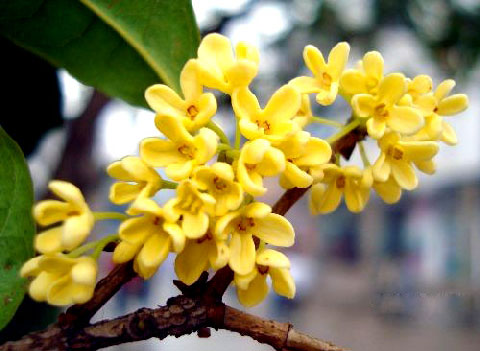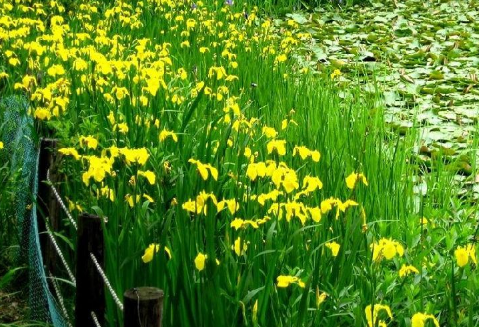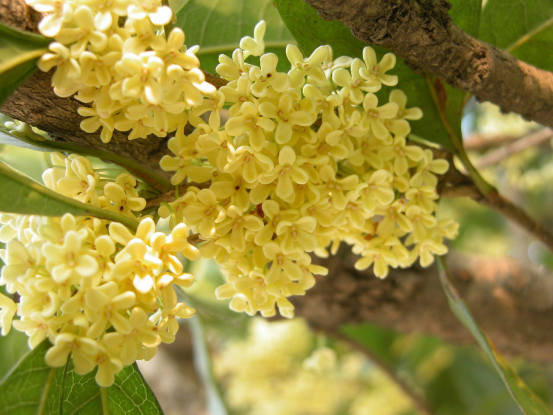Culture method of osmanthus fragrans
1. Watering
Sweet-scented osmanthus is resistant to drought and waterlogging, and watering once a day becomes better. in summer, we choose to water in the morning and evening with low temperature, and in winter, we choose noon watering with high temperature. we need to pay attention to the amount of watering and not to water too much.
2. Light temperature
Potted plants can be cultivated in the open air in the south, and should be placed in a sunny place in winter to fully accept direct sunlight. The room temperature should be kept above 5 ℃, but not more than 10 ℃. The room temperature of Osmanthus fragrans overwintering is 0: 5 ℃.
3. Potted soil
Sweet-scented osmanthus has no special requirements for basin soil, so it can be mixed with ordinary garden soil and sediment.
4. Fertilization
Osmanthus fragrans should be provided with sufficient fertilizer, nitrogen fertilizer should be applied twice in the peak growth period, and phosphorus fertilizer should be applied mainly before flower bud differentiation and flowering. Note that we have to loosen the soil before applying fertilizer.
5. Pruning
The best time for pruning is to prune the closely growing branches after autumn, and cut off the overgrown branches, withered branches, disease and insect branches and dense thin branches after flowering. If the sweet-scented osmanthus plant grows too unsightly, we can choose to cut off the branches and trim the tree.
6. Insect pests
The common pests of sweet-scented osmanthus are leaf wasp, whitefly, mite, long white scale, yellow moth and so on. Leaf wasp, whitefly and mite can be sprayed with dimethoate, and dimethoate or fenitrothion can be used to spray off the first and second generation nymphs except artificial brushing.

How to raise sweet-scented osmanthus trees, the culture methods and matters needing attention of sweet-scented osmanthus trees
Osmanthus fragrans, also known as Lin Xi Shu, has been cultivated for 2500 years in China. Osmanthus fragrans is a long sunshine plant, which is suitable for planting under the conditions of sufficient light, fertile soil and good drainage performance. The ornamental value is high, and some varieties of flowers are edible. In this paper, the culture methods and matters needing attention of sweet-scented osmanthus trees are shared with you.
Culture methods of Osmanthus fragrans
Sweet-scented osmanthus trees are often seen in gardens in China, and the more common varieties are osmanthus, silver osmanthus, cinnamon and four seasons osmanthus, among which the economic value of osmanthus is higher, and sweet-scented osmanthus trees are generally propagated by cutting, striping and grafting, but the survival rate is not high. To a certain extent, the development of sweet osmanthus is limited.
The cultivation of sweet-scented osmanthus trees is mostly carried out in early spring. First, dig a big hole in the place where the soil is fertile and sunny, apply some organic fertilizer, at the same time, apply some plant ash, apply fertilizer and water once or twice in July or August, apply rotten compost before winter, apply available nitrogen once in March of the following year, apply available phosphorus and potassium fertilizer again in July, and apply organic fertilizer again in October. At ordinary times, attention should be paid to weeding and watering as well as the prevention and control of diseases and insect pests, which can make sweet-scented osmanthus trees bloom luxuriantly year after year and have a long aroma.
In addition, potted sweet-scented osmanthus trees should pay more attention to soil selection, watering and fertilization, as well as pruning and pest control.
Points for attention of Osmanthus fragrans
When watering sweet-scented osmanthus trees, we should pay attention to less watering before new shoots grow, less watering in cloudy and rainy days, and more watering in dry weather in summer and autumn. Sweet-scented osmanthus trees should master the amount of watering when they bloom in autumn to keep the basin water moist, too wet will cause falling flowers.
Sweet-scented osmanthus trees should be well fertilized, especially the lack of phosphate fertilizer will affect the branches of sweet-scented osmanthus trees, and the flowers are not fragrant. The root system of sweet-scented osmanthus tree is well developed, and the adult sweet-scented osmanthus tree will shoot every spring and autumn, so we should pay attention to pruning, keep the plant shape beautiful, balance the physiological nutrition of sweet-scented osmanthus tree and promote the growth of flower buds.
If you want to raise a sweet-scented osmanthus tree, in addition to the usual daily management, but also add careful maintenance, pay attention to the prevention and control of diseases and insect pests, need timely spraying control. The cultivation methods and matters needing attention of sweet-scented osmanthus trees are introduced here. For more information on flower culture, please pay attention to the encyclopedia of China Agricultural Chemical Merchants Network.
Extended reading:
Sweet-scented osmanthus tree planting technology, culture method, sweet-scented osmanthus flower language, function and effect
How to raise potted osmanthus trees? Culture methods of potted sweet-scented osmanthus trees
The fragrance of sweet-scented osmanthus floats ten miles and is liked by many friends. Many friends will choose to raise a pot of sweet-scented osmanthus trees at home. How to raise potted sweet-scented osmanthus trees? Next, I would like to introduce the cultivation methods of potted sweet-scented osmanthus trees.
First, the placement of potted sweet-scented osmanthus trees:
Sweet-scented osmanthus bonsai should be placed in a warm and sunny place and should be properly sheltered in summer to avoid direct light. The area north of the Yangtze River must be put indoors in winter, and it is safe to keep 0-5 ℃ at room temperature. You can leave the room before and after the sting in the spring of the following year.
Second, the watering method of potted sweet-scented osmanthus trees:
The pot soil of sweet-scented osmanthus trees should grasp the principle of whether it is dry or irrigated, and if it is watered thoroughly. Generally, it is watered every 3-4 days in spring and autumn, once every day in summer and every 7-10 days in winter. It must be watered in the morning and evening in summer and around noon in winter, so that the water temperature is close to the soil temperature and does not cause sudden cold and heat and damage the root system. Appropriate amount of water should be watered in autumn, and the basin soil should be prevented from getting too wet or stagnant water in the rainy season.
3. Fertilization methods for potted sweet-scented osmanthus trees:
The bonsai of sweet-scented osmanthus trees is mainly for viewing flowers and should be provided with adequate fertilizer. During shoot shooting, nitrogen fertilizer could be applied 1-2 times to promote the growth of branches and leaves, while phosphorus fertilizer was mainly applied before flower bud differentiation and flowering. Before applying fertilizer, the basin soil should be a little drier, and it is appropriate to loosen the soil so that the fertilizer can be absorbed. Water should be watered once on the second day of fertilization. If compost or stable compost is used, it must be completely rotten before use. When applying chemical fertilizer, the concentration of calcium superphosphate should not exceed 2%.
4. Pruning methods of potted sweet-scented osmanthus trees:
The shaping and pruning of sweet-scented osmanthus trees should be carried out after autumn, and the upper branches should be cut off to balance the tree. The branches that are too dense should be thinned, and the diseased branches should be removed to concentrate nutrients for flowering. Plastic pruning combined with water and fertilizer management can improve the robust growth of sweet-scented osmanthus bonsai and maintain a graceful posture.
Fifth, change the pot of potted sweet-scented osmanthus trees:
Sweet-scented osmanthus bonsai can be turned over and changed soil every 2-3 years. The new pot should be larger to facilitate the root growth of sweet-scented osmanthus. Combined with turning the basin, cut off part of the old and withered roots, use bamboo sticks to remove part of the old soil, replace it with loose and fertile new culture soil, and place rotten cake fertilizer at the bottom of the basin as the base fertilizer, the fill must be compacted, which can promote sweet-scented osmanthus blossom and luxuriant leaves.
6. diseases and pests to be controlled in potted sweet-scented osmanthus trees:
The common diseases of sweet-scented osmanthus include leaf spot, coal pollution, algal spot, root rot, iron deficiency and so on.
1. Leaf spot, coal pollution and algal spot can be controlled by spraying 0.5 Bordeaux solution or 5% carbendazim 500-1000 times.
2. For the prevention and control of root rot, attention should be paid to keeping the soil loose and permeable, without stagnant water; if root rot is caused by fungi, 200-300 times solution of benzoammonium can be used to irrigate the roots.
3. The common pests of sweet-scented osmanthus are leaf wasp, whitefly, mite, white scale, yellow moth and so on. Leaf wasps, whitefly and mites can be sprayed with 1500-3000 times of dimethoate. In addition to manual brushing, the scale can be sprayed with 1000 times of omethoate or 500 times of fenitrothion.
These are the breeding methods of potted sweet-scented osmanthus trees, and friends who like potted sweet-scented osmanthus trees can refer to the above methods for reasonable breeding.
- Prev

Sowing method of Acorus calamus
1. The fruit of Gladiolus is basically ripe in mid-January, and the seeds can be taken out of the picked fruit. The seeds can be sown after picking. If you want to store the seeds, dry them first, refrigerate them at a low temperature in the refrigerator, and sow the seeds in March or September next year. two。 Sow seeds and flatten loose soil in changing pots.
- Next

Matters needing attention in cultivating sweet-scented osmanthus trees
1. Pay attention to the times and amount of watering. Too much watering will cause stagnant water in the roots, which may seriously cause plant death. 2. Sweet-scented osmanthus is a typical long-sunshine plant. If it does not get enough light in the growing period, the plant is easy to grow and affect the flowering period. 3. Potted sweet-scented osmanthus needs to be changed once every two years.
Related
- Fuxing push coffee new agricultural production and marketing class: lack of small-scale processing plants
- Jujube rice field leisure farm deep ploughing Yilan for five years to create a space for organic food and play
- Nongyu Farm-A trial of organic papaya for brave women with advanced technology
- Four points for attention in the prevention and control of diseases and insect pests of edible fungi
- How to add nutrient solution to Edible Fungi
- Is there any good way to control edible fungus mites?
- Open Inoculation Technology of Edible Fungi
- Is there any clever way to use fertilizer for edible fungus in winter?
- What agents are used to kill the pathogens of edible fungi in the mushroom shed?
- Rapid drying of Edible Fungi

